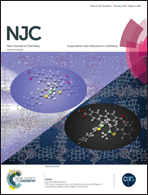Gel properties of T-shaped tetrathiafulvalene–pyridazine conjugates and F4TCNQ-induced morphological transformation†
Abstract
A new series of T-shaped organic π-conjugate organogelators, monopyridazine–TTFs, were synthesized and characterized. All of the gelators could gelate the aromatic solvents, such as benzene, toluene and chlorobenzene, and the length of the alkyl chain had a certain influence on the gelation behavior. Interestingly, the gelators could react with 2,3,5,6-tetrafluoro-7,7,8,8-tetracyanoquinodimethane (F4TCNQ) to form the charge-transfer complex organogels. FT-IR, UV-Vis, 1H NMR and CV experiments revealed that the cooperation of hydrogen bonding, π–π, and CT interactions was the main driving force for the formation of the native and CT gels. The FE-SEM images of the native gels reveal the characteristic gelation morphologies of fibrous structures, whereas the morphologies of CT complex gels show the amorphous block aggregates. XRD study of the native gel and the CT complex gel of 1b in DMF suggests that the molecules maintain lamellar and hexagonal columnar molecular packing models in the gel phase, respectively. Furthermore, the DMF gel of 1b could be destroyed only by the addition of the fluorine ions, while the toluene gel could be transformed into solution or suspension after adding halogen ions.


 Please wait while we load your content...
Please wait while we load your content...